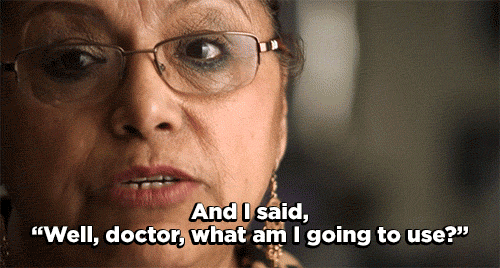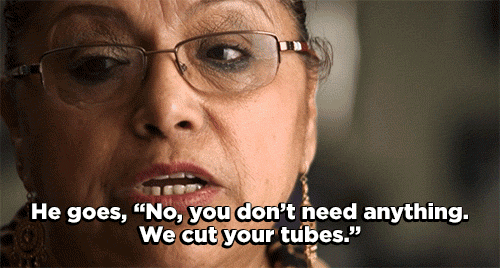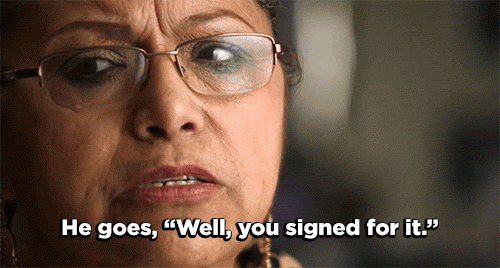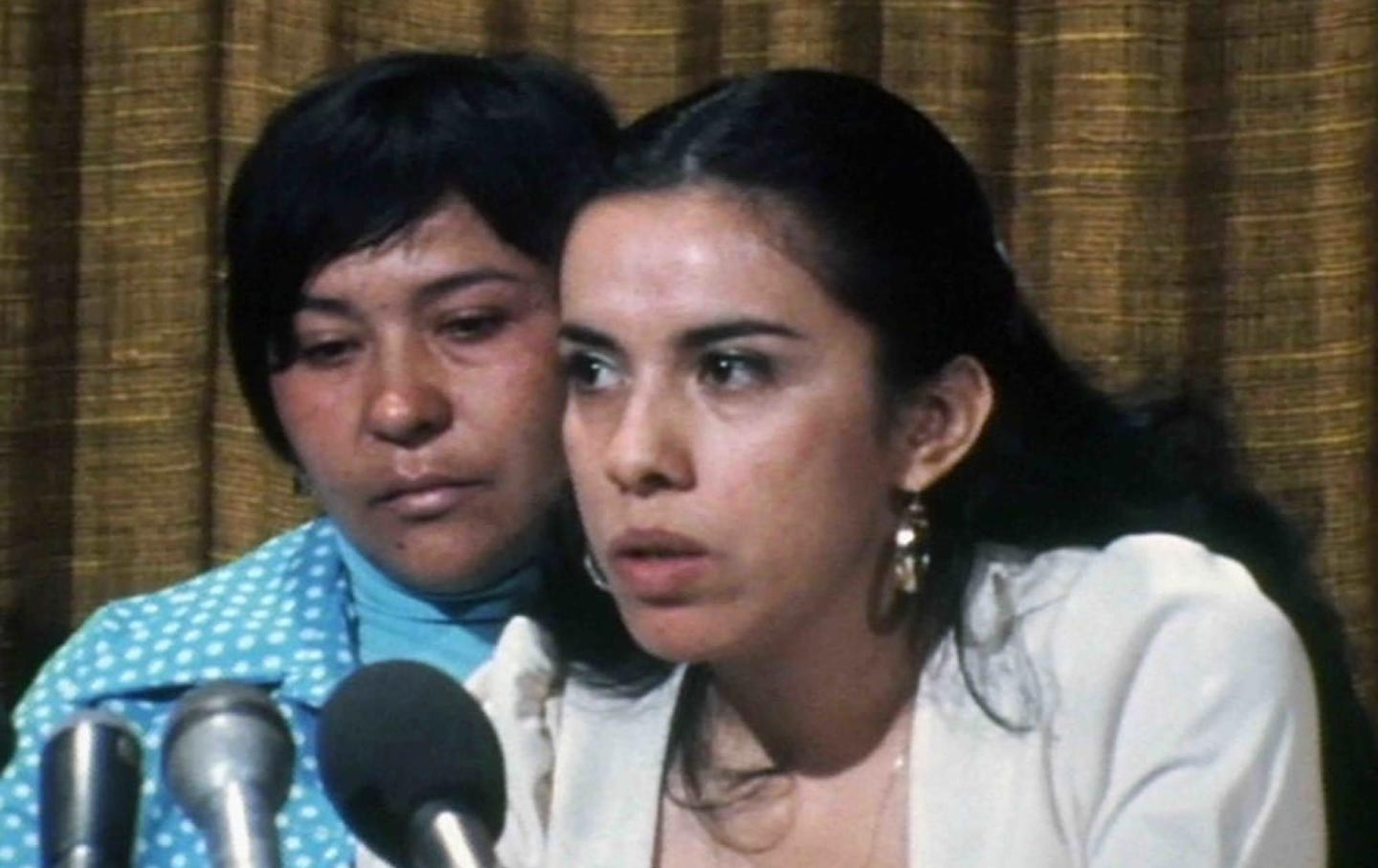Unknowingly Sterilized
This mother of one was sterilized at twenty three years old. She had no idea what the operation was and thought later on she could reverse the operation if she wanted. When the doctor told her that he had “cut (her) and sewn (her) with black thread”, she had no idea that he meant he had tied her tubes and permanently sterilized her.
Thousands of women were coerced or unlawfully sterilized in the 1900s. It is time for these women’s stories to be heard. Latina women have been historically and continually denied agency over their bodies and reproductive choices.
Looking Back: Latina women and other minority women were discriminated against and coerced into sterilization as part of eugenic and overpopulation programs in the US in the 1900s. Yet why do we never their stories in the history of the reproductive rights movement? #LATS3
— Haley Ramsden (@haley_ramsden) April 16, 2018
Puerto Rico
The history of reproductive injustices against Latina women begins in Puerto Rico. Once PR was incorporated into the US as a commonwealth in 1898 and Congress officially made Puerto Ricans U.S citizens under the Jones-Shafroth Act in 1917, mainland sociologists, economists, politicians and many others became fascinated with Puerto Rico’s economic difficulties and ultimately, the reproductive organs of Puerto Rican women.
So what did the bodies of Puerto Rican women have to do with Puerto Rico’s economy? Both the US federal government and private academics blamed overpopulation on the island for the high rates of poverty and unemployment. These mainland and also Puerto Rican “over-populationists” advocated for smaller families, greater access to birth control, and eventually sterilizations on the island. The federal government passed Law 116 in 1937 which legalized sterilization, created a eugenics board to monitor the population “problem” on the island, and allocated funds towards sterilizations.
A feminist or genocidal campaign?
Briggs: “it is not an argument that working class women chose to be sterilized, it is an argument that there is no evidence that there was a representative campaign to force them.” So, what do we make of La Operación? #LAT3
— Matt Garcia (@mattjgarcia68) April 15, 2018
As Professor Garcia points out, academics still argue whether there was a campaign targeted at forcing Puerto Rican women into sterilization.
Many Puerto Rican women welcomed the new birth control methods and sought out their own sterilizations. Other groups, like the Nationalist Party and Catholic Church saw these measures as attacks on the Puerto Rican family or morally wrong.
Nevertheless, Puerto Rican women (and men) were used as guinea pigs for medical trials of new birth control methods like the pill and often suffered severe side effects like nausea, dizziness, and occasionally reproductive cancers.
Even more concerning, were the high rates of sterilization among Puerto Rican women as a result of the overpopulation campaign. Federal funds were used to advocate for sterilizations and fund the procedure, with efforts mostly targeted at lower-class women who the eugenics board feared were overpopulating the island with “lesser” children that would contribute to the social and economic issues on the island.
As a result of these efforts, sterilization became so common on the island that it was simply referred to as “la operación”. Between 1930 and 1970, 1/3 of Puerto Rican women were sterilized, the highest rate of sterilization in the world. Additionally, these efforts were often not presented truthfully to women – over 1/3 of sterilized women did not realize that tubal ligation was a permanent form of contraception (Krase). 21% of women who were sterilized during this period felt some regret while others actively sought out their own sterilizations and saw the campaign as a movement for “libertad”(Boring).
Antonio Silva, who was the director of the family planning program in Puerto Rico in 1960 and again from 1974-1976 was accused of carrying out plans for sterilizations of thousands of women. He declared sterilization “necessary” and argued that the sterilization rate of 35% of all Puerto Rican woman of childbearing age was not enough and set a goal of 5,000 sterilizations for the fiscal year1974-5 (Ramirez and Seipp). Here he explains his goals for controlling the population in Puerto Rico, specifically aimed at lower-class women working in factories.
Los Angeles, California
Consuelo Hermosillo’s story
Consuelo Hermosillo was coerced into sterilization at 23 years old, married, and after the birth of her third child. She sat in pain on a gurney in the hallway of Los Angeles County-USC Medical Center waiting to see a doctor but was told, in Spanish, “You better sign those papers or your baby is going to die, as soon as you sign, they’ll take you in.” She was essentially forced into approving her own sterilization to protect her baby’s healthy delivery and her own health. From that day forward, to the day of her death in 2010, Hermosillo doesn’t remember signing papers for consent of her sterilization.
Hermosillo was one of ten Mexican-American plaintiffs in the case Madrigal vs. Quilligan. The ten women were unlawfully sterilized at the Los Angeles County U.S.C Medical Center between 1971 and 1974 and given consent forms in English when they only spoke Spanish. Some were coerced into signing consent while in labor or under anesthesia.
Antonia Hernández, featured above at a press conference announcing the law suit Madrigal v. Quilligan, represented the ten Mexican-American women. Ultimately, the judge ruled in favor of the defending doctors, blaming the women’s “cultural background” as immigrants from rural Mexico for the “misunderstanding”.
Sterilizations in California and the US
California led the country in the number of sterilization procedures performed on men and women with approximately 20,000 sterilizations taking place in state institutions, most of them at the discretion of eugenic boards.
California, and many other states created eugenic boards aimed at the mentally ill and to control the population of minority women because of concerns about rising populations of non-white populations and prejudices about the welfare use and illegitimacy of minority women. Many sociologists, economists, and politicians attributed the “population bomb” and family structure of Latino families and other minority groups to their social and economic “issues” and thus recommended controlling the population of minority women through birth control and sterilization programs.
Thus it is unclear whether doctors took matters into their own hands or were taught to impose sterilization onto minority women. However, it is clear that these sterilizations were often coerced and unlawful. Mexican-American women like Hermosillo were often tricked into consent because they didn’t speak English or scared into signing due to their immigration status.
Other women were literally held in suffering until they consented. Dr. Karen Benker, who testified against the doctors in Madrigal vs. Quilligan, once saw a medical resident hold a hypodermic needle filled with painkiller in front of an African-American woman in labor and say, ““You want this? You want the pain to go away? Well, sign this [sterilization consent] paper!”(Valdes).
These women’s stories deserve to be heard. Thousands of women were coerced into sterilizations, not as “misunderstandings” but as deliberate attacks on the reproductive rights of Latina women and other minority women.
Restorative Justice and Moving Forward
The fight for reproductive justice for Latina women is not over. There is still so much work to be done but thanks to brave women like García who shed light on the experimental birth control trials and sterilizations in Puerto Rico and Hernández who fought for justice for the Mexican-American plaintiffs, there has been progress. For example, now there is a 72 hour waiting period before patients can be sterilized and consent papers must be offered in both Spanish and English.
For too long others, particularly white men, have been trying to regulate, control, and terminate the reproductive abilities of Latina women. It is her choice and her choice alone to decide if she wants children, how many, and when and how she wants to have children. There is no “right” way of having and raising children and certainly the unlawful sterilization of thousands of Latina women has done nothing to improve their livelihoods. These women and their families deserve restoration. There are an estimated 600 Latina women who are still living in the state of California who are victims of sterilization abuse but have yet to be paid reparations, when states Virginia and North Carolina have set up funds to compensate survivors of eugenics based sterilization programs (Krase).
Moving forward, in addition to reparations, it is important to reflect on these inequities and protect the reproductive rights of all women, particularly Latina women, who have the least access to affordable reproductive services in the US (Latina Institute).
References:
- Krase, Kathryn. “History of Forced Sterilization and Current U.S. Abuses.” Our Bodies Ourselves, 14 Oct. 2014, www.ourbodiesourselves.org/health-info/forced-sterilization/.
- Boring, Catherine Chase, Roger W. Rochat, and Jose Becerra. “Sterilization regret among Puerto Rican women.” Fertility and sterility 49.6 (1988): 973-981.
- Ramirez de Arellano, Annette B., and Conrad Seipp. “Colonialism Catholicism and contraception: a history of birth control in Puerto Rico.” (1983).
- Valdes, Marcela. “When Doctors Took ‘Family Planning’ Into Their Own Hands.” The New York Times, The New York Times, 1 Feb. 2016, www.nytimes.com/2016/02/01/magazine/when-doctors-took-family-planning-into-their-own-hands.html.
- National Latina Institute for Reproductive Health | Salud | Dignidad | Justicia, NLIRH, 2014, www.latinainstitute.org/.





